Related Research Articles

Sergei Sergeyevich Prokofiev was a Russian Soviet composer, pianist and conductor. As the creator of acknowledged masterpieces across numerous music genres, he is regarded as one of the major composers of the 20th century. His works include such widely heard pieces as the March from The Love for Three Oranges, the suite Lieutenant Kijé, the ballet Romeo and Juliet—from which "Dance of the Knights" is taken—and Peter and the Wolf. Of the established forms and genres in which he worked, he created – excluding juvenilia – seven completed operas, seven symphonies, eight ballets, five piano concertos, two violin concertos, a cello concerto, a symphony-concerto for cello and orchestra, and nine completed piano sonatas.

The Bournemouth Symphony Orchestra (BSO) is an English orchestra with a remit to serve the South and South West of England. Founded in 1893, the BSO has developed a reputation as one of the UK's major orchestras and has worked with many of the world's leading composers, conductors and performers. Originally based in Bournemouth, the BSO moved its offices to the adjacent town of Poole in 1979.
Symphony No. 9 in E-flat major, Op. 70, was composed by Dmitri Shostakovich in 1945. It was premiered on 3 November 1945 in Leningrad by the Leningrad Philharmonic Orchestra under Yevgeny Mravinsky.

Symphony No. 4, Op. 47 (112), is actually two works by Sergei Prokofiev. The first, Op. 47, was written in 1929 and premiered in 1930; it lasts about 22 minutes. The second, Op. 112, is a large-scale revision and lengthening from 1947; it lasts about 37 minutes. Both use musical material originally written for Prokofiev's ballet The Prodigal Son. The two works are stylistically different, reflecting their respective compositional contexts. They are formally different too: the instrumentation and scope of the revision is larger.

Nikolai Yakovlevich Myaskovsky or Miaskovsky or Miaskowsky, was a Russian and Soviet composer. He is sometimes referred to as the "Father of the Soviet Symphony". Myaskovsky was awarded the Stalin Prize five times, more than any other composer.
Nicolas Oreste Flagello, was an American composer and conductor of classical music. He was one of the last American composers to develop a distinctive mode of expression based wholly on the principles and techniques of European late romanticism.

The Symphony No. 6 in E-flat minor, Op. 111, by Sergei Prokofiev was completed and premiered in 1947. According to Simon Morrison, its premiere was the "last unhampered, unmediated success" the composer would ever experience.
Peter Donohoe CBE is an English classical pianist.
Sergei Prokofiev composed and compiled his Waltz Suite, Op. 110, during the Soviet Union's post-Great Patriotic War period of 1946–1947.
Alla Pavlova is a Russian composer of Ukrainian origin, best known for her symphonic work. Pavlova currently resides in Brooklyn, New York.
Eduardo Alonso-Crespo is an Argentine composer of classical music.

Sergei Prokofiev's Lieutenant Kijé music was originally written to accompany the film of the same name, produced by the Belgoskino film studios in Leningrad in 1933–34 and released in March 1934. It was Prokofiev's first attempt at film music, and his first commission.
Konstantin Saradzhev was an Armenian conductor and violinist. He was an advocate of new Russian music, and conducted a number of premieres of works by Pyotr Ilyich Tchaikovsky, Modest Mussorgsky, Igor Stravinsky, Sergei Prokofiev, Nikolai Myaskovsky, Dmitri Shostakovich, and Aram Khachaturian. His son Konstantin Konstantinovich Saradzhev was a noted bell ringer and musical theorist.
Alan Shulman was an American composer and cellist. He wrote a considerable amount of symphonic music, chamber music, and jazz music. Trumpeter Eddie Bailey said, "Alan had the greatest ear of any musician I ever came across. He had better than perfect pitch. I've simply never met anyone like him." Some of his more well known works include his 1940 Neo-Classical Theme and Variations for Viola and Piano and his A Laurentian Overture, which was premiered by the New York Philharmonic in 1952 under the baton of Guido Cantelli. Also of note is his 1948 Concerto for Cello and Orchestra which was also premiered by the New York Philharmonic with cellist Leonard Rose and conductor Dmitri Mitropoulos. Many of Shulman's works have been recorded, and the violinist Jascha Heifetz and jazz clarinetist Artie Shaw have been particular exponents of his work both in performance and on recordings.

Chout, Op. 21, is the usual English-language title of a ballet by Sergei Prokofiev, written in two versions between 1915 and 1921. It is sometimes known as "The Tale of the Buffoon", or simply "The Buffoon". There also exists a symphonic suite from the ballet, Op. 21 bis, which is much more often performed than the full ballet score.
Hubert Klyne Headley (1906–1996) was an American composer, pianist and organist.

Theodore Kuchar is a Ukrainian American conductor of classical music and a violist.
Symphony No. 3 (1938) is a symphony in four movements composed by American composer Howard Hanson (1896–1981). The first three movements were finished in 1936, a revision in 1938 added the finale movement to the symphony. A typical performance time is approximately 36 minutes. The work, commissioned by the CBS Symphony Orchestra, was written in commemoration of the 300th anniversary of the first Swedish settlement in Delaware in 1638.

The Academic Symphony Orchestra of the Lviv National Philharmonic is one of the oldest symphony orchestras in Ukraine.
References
- ↑ Nestyev, Israel (1961). Prokofiev. Stanford: Stanford University Press. pp. 374. ISBN 978-0804705851.
- ↑ Nestyev, Israel (1961). Prokofiev. Stanford: Stanford University Press. pp. 328. ISBN 978-0804705851.
- ↑ Morrison, Simon Alexander (2009). The People's Artist: Prokofiev's Soviet Years. Oxford University Press, USA. p. 440. ISBN 978-0-19-518167-8.